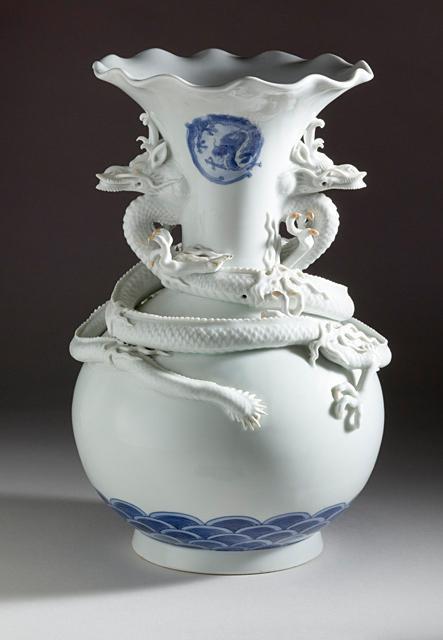If you have ever dined at a Chinese restaurant, you have probably seen something printed with the signs of twelve animals—rat, ox, tiger, hare, dragon, snake, horse, ram, monkey, rooster, dog, and boar—known as the zodiac animals. The Chinese use these signs to mark years, a system that follows the lunar calendar instead of the Gregorian calendar used in the West. The first day of a lunar year is the most important holiday, celebrated in many countries in Asia, such as China, Korea, and Vietnam.
January 23, 2012, is the first day of the year of the dragon. To celebrate this special occasion, we have installed a gallery with dragon related works from LACMA’s permanent collection. The dragon is the only mythical animal among the twelve zodiac animals, bringing special auspices to the year of the dragon. In addition, the dragon is believed to possess supernatural powers such as controlling the rain. As a result, it is one of the most popular themes for Asian artists.

Vase with Everted Fluted Lip and Raised Dragon Décor, Japan, nineteenth century, gift of Allan and Maxine Kurtzman

Jar with Dragon and Clouds, Korea, Joseon dynasty (1392-1910), nineteenth century, gift of Mr. and Mrs. Jae Min Chang and The Korea Times
In the gallery, you will see ceramics from China, Korea, Japan, and Vietnam. Although the objects are different shapes and sizes and were made at different times in different regions, each piece has a dragon (or a pair of dragons) as its decorative motif. The earliest piece displayed in the gallery is a bronze mirror made in China circa 200 BC, where the interlaced bodies of the dragons emphasize the animal’s long and curvilinear body.
In ancient China, the dragon was seen as the embodiment of the emperor, who claimed himself as a “son of heaven.” In the Ming and Qing dynasties (1368–1911), only the imperial family was allowed to use dragons to decorate their homes, furniture, and clothes. The embroidered image of a dragon on display in this special installation is a rank badge, probably worn by a prince in the seventeenth century.
Badge (Lizi) of the Imperial Prince with Dragon, China, late Ming dynasty (1368-1644), mid-seventeenth century, gift of Miss Carlotta Mabury
The dragon emerges from a background of waves and clouds. The waves symbolize the yin element of the ocean, and the clouds the yang element of the sky. Here the dragon resides within the perfect harmony of yin and yang, which can also be seen as the imperial house’s supreme power over the universe. Other works included in the gallery, such as a Japanese ink painting of a dragon and a jade belt buckle in the shape of a dragon, testify to the popularity of the dragon in Asia.
Christina Yu Yu, Assistant Curator, Chinese and Korean Art





